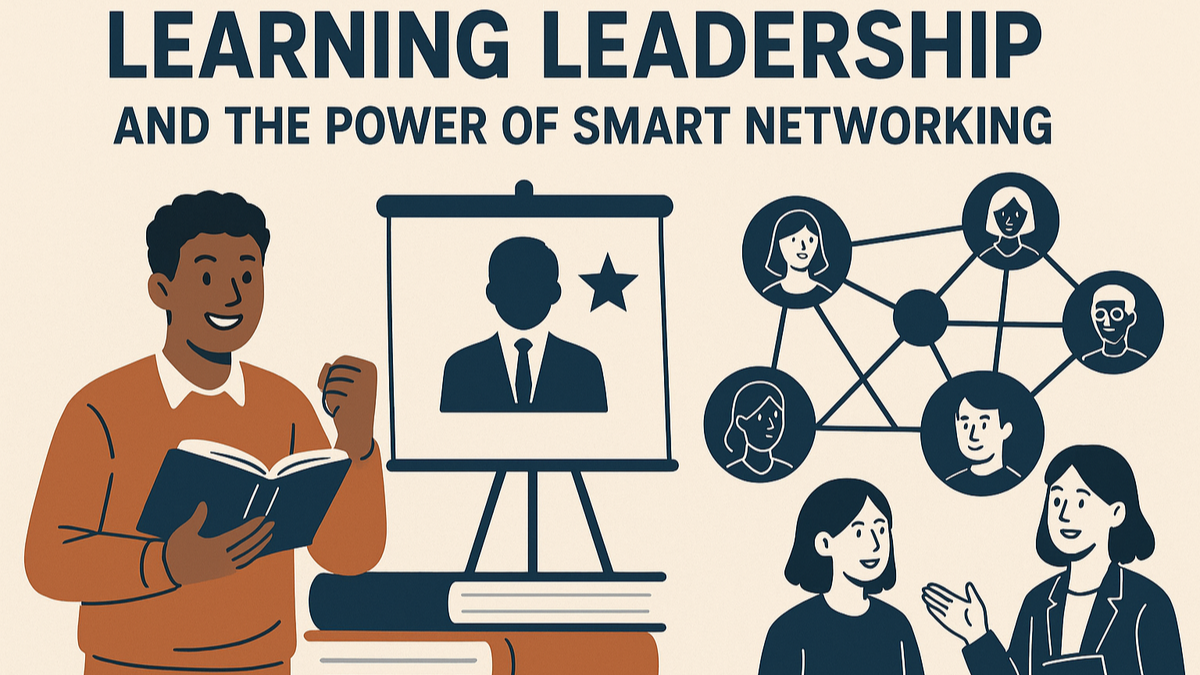Learning Leadership And The Power Of Smart Networking. In today’s rapidly evolving business landscape, the intersection of leadership development and strategic networking has become more crucial than ever. Organisations that understand this synergy position themselves not just to survive market changes but to thrive as industry leaders. At Mahad Group, we recognise that exceptional leadership, combined with smart networking, creates exponential value that goes far beyond traditional business metrics.
Learning Leadership
In the 21st century, Learning Leadership demands a fundamental shift from traditional command-and-control models to more adaptive, relationship-centred approaches. Today’s leaders must navigate complex global markets, diverse teams, and rapidly changing technologies while maintaining authentic connections with stakeholders at every level.
Key characteristics of modern leaders include:
Emotional Intelligence as a Foundation The ability to understand and manage emotions—both your own and others’—has become the cornerstone of effective leadership. Leaders who master emotional intelligence create environments where innovation flourishes and teams perform at their peak. This involves active listening, empathy, and the capacity to inspire others through challenging times.
Adaptive Problem-Solving Markets shift overnight, technologies disrupt entire industries, and global events reshape business landscapes. Modern leaders must be comfortable with ambiguity and excel at making informed decisions with incomplete information. This requires continuous learning, scenario planning, and the courage to pivot when circumstances demand change.
Digital Fluency and Innovation Mindset Understanding technology’s role in business transformation isn’t optional—it’s essential. Leaders need not be technical experts, but they must grasp how digital tools can enhance operations, improve customer experiences, and create competitive advantages. This includes embracing automation, data analytics, and emerging technologies that drive efficiency and growth.
Smart Networking: Beyond Traditional Relationship Building
Learning Leadership: Smart networking transcends collecting business cards at conferences or connecting on LinkedIn. It’s about building meaningful, mutually beneficial relationships that create value for all parties involved. This strategic approach to relationship building becomes a powerful leadership tool that opens doors, generates opportunities, and provides access to insights that can transform businesses.
The Strategic Framework for Smart Networking:
Value-First Approach: Effective networkers always lead with value. Before asking for anything, consider what you can offer others. This might be industry insights, introductions to relevant contacts, expertise in solving specific problems, or simply being a trusted sounding board for ideas. When you consistently provide value, people naturally want to reciprocate and maintain the relationship.
Quality Over Quantity Building a network of 1,000 superficial connections pales in comparison to cultivating 50 meaningful relationships. Focus on individuals who align with your values, complement your skills, or operate in areas where you can create mutual value. These deeper connections yield better outcomes and more fulfilling professional relationships.
Diversification Across Industries and Roles The most powerful networks span multiple industries, functions, and levels of seniority. A manufacturing executive who maintains relationships with technology innovators, financial experts, and startup entrepreneurs gains perspectives that purely industry-focused networks cannot provide. This diversity of thought often leads to breakthrough innovations and unexpected opportunities.
Long-term Relationship Investment. Smart networking requires patience and consistency. The most valuable connections often develop over years, not months. Regular check-ins, sharing relevant opportunities, celebrating others’ successes, and offering support during challenges build the trust that transforms professional acquaintances into powerful allies.
The Leadership-Networking Synergy
Learning Leadership: When leadership skills and smart networking combine, they create a multiplier effect that increases individual and organisational success. Leaders who master this combination become connectors, bringing together diverse groups to solve complex problems and create innovative solutions.
Creating Ecosystem Advantages Outstanding leaders don’t just build teams—they build ecosystems. Leveraging their networks, they can access specialised expertise, identify emerging market trends, and create partnerships that would have been impossible through traditional channels. This ecosystem approach provides competitive advantages that are difficult for competitors to replicate.
Knowledge Acceleration Smart networkers learn faster because they tap into collective intelligence. Instead of making every mistake personally, they learn from others’ experiences. They stay ahead of industry trends by maintaining relationships with thought leaders, early adopters, and market disruptors. This accelerated learning translates into better strategic decisions and faster market responses.
Influence and Impact Multiplication Leaders with strong networks can influence outcomes that are far beyond their direct organisational reach. When facing industry challenges or pursuing ambitious goals, they can mobilise resources, expertise, and support from their extended network. This multiplied influence enables them to tackle larger problems and achieve more significant results.
Practical Strategies for Implementation
Develop Your Personal Leadership Philosophy. Before building external relationships, clarify your leadership values and approach. What kind of leader do you want to be? What impact do you want to make? This self-awareness becomes the foundation for authentic networking, as people connect with leaders who demonstrate genuine purpose and consistency.
Create Systematic Networking Processes: Transform networking from random activities into systematic processes. Set goals for new relationships, schedule regular follow-ups with existing contacts, and track the value you’re providing to others. Use CRM tools to maintain detailed records of interactions, preferences, and opportunities to help your network contacts.
Invest in Continuous Learning. Stay current with industry trends, emerging technologies, and leadership best practices. This knowledge becomes valuable currency in networking relationships. When you can provide insights that help others succeed, you become someone they want to maintain in their network.
Practice Generous Leadership: Make introductions between people in your network who could benefit from knowing each other. Share opportunities that might not be right for you but perfect for someone in your network. Offer your expertise to help others solve problems. This generous approach creates goodwill that returns exponentially over time.
Leverage Digital Platforms Strategically Use social media and professional platforms to share valuable content, engage meaningfully with others’ posts, and maintain visibility with your network. However, ensure digital interactions complement, rather than replace, personal connections. The objective is to maintain awareness and add value during in-person interactions.
Measuring Success and ROI
Learning Leadership: Smart networking and leadership development require investment, and like any business initiative, their return on investment should be measurable. Success metrics might include access to new markets, recruitment of high-quality talent, partnerships that drive revenue growth, or insights that lead to successful strategic decisions.
Track relationship development through systematic follow-up, mutual value creation, and the quality of opportunities that emerge from your network. Monitor whether networking enhances your leadership effectiveness by observing improvements in team performance, stakeholder engagement, and organisational results.
Building Organisational Networking Culture
Organisations that excel in smart networking integrate it into their culture. This means creating systems that encourage employees at all levels to build meaningful professional relationships; provide resources and training for effective networking; and recognise the value that strong external relationships bring to an organisation.
Learning Leadership: Encourage cross-functional collaboration, support employee participation in industry events, and create internal platforms for knowledge sharing. When networking becomes part of DNA, the collective network effect creates competitive advantages that individual efforts cannot match.
Future-Proofing Through Relationships
As artificial intelligence and automation reshape industries, the distinctly human elements of leadership and relationship building become more valuable, not less. While machines can process data and execute routine tasks, they cannot replace the trust, creativity, and collaborative problem-solving that emerge from strong human relationships.
Leaders who master a combination of authentic leadership and strategic networking position themselves and their organisations for long-term success. They create resilient networks that can adapt to changing circumstances, provide support during challenging times, and offer opportunities for growth and innovation.
Conclusion: The Compound Effect of Leadership and Networking
Learning Leadership: The most successful leaders understand that leadership and networking are not separate skills but interconnected capabilities that reinforce each other. Great leaders build strong networks, and those networks create opportunities for leadership impact. This compound effect accelerates career development, enhances organisational performance, and creates lasting value for all stakeholders.
At the Mahad Group, we recognise that investing in leadership development and smart networking capabilities creates sustainable competitive advantages. By developing leaders who can build and leverage powerful networks, we position ourselves to navigate future challenges and capitalise on emerging opportunities.
Learning Leadership: The journey of learning leadership and mastering smart networking is ongoing. It requires commitment, authenticity, and patience. However, for those willing to invest, the returns, in terms of personal growth, professional opportunities, and organisational success, are extraordinary.
The question isn’t whether you can afford to invest in leadership and networking development. The question is whether you can afford not to.


